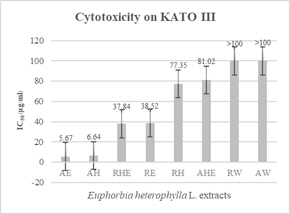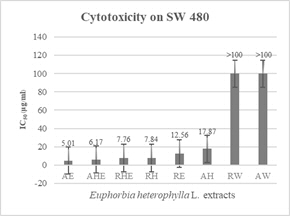Introduction
Cancer is the
leading cause of death in the world. Empirical evidence compiled by the National Center
for Health Statistics reveals that the trend of the incidence and mortality
rates is cancer. In the United States, an estimated 1,958,310 new
cancer cases and 609,820 cancer-related fatalities are expected in 2023 [1]. In Thailand, the annual number of cancer related deaths is increasing
every year. Among the various types of cancer prevalent in
Thailand, liver and bile duct cancer, lung cancer, and colon and rectal cancer
emergence are the most commonly diagnosed forms [2]. Various cancer treatments are available, including
alternative medicine used in conjunction with modern medicine to boost patient
immunity. Diet plays a crucial role in cancer prevention, with
foods rich in antioxidants. Thai medicinal plants are a major source of those
compounds such as phenolic, flavonoid, vitamin, and catechin which involve in
preventing and reducing the risk of cancer [3].
In the Thai traditional medicine framework, cancer is the results
of human body deterioration and an imbalance in the tri-elemental system
consisting of Pitta, Wata, and Semha. This imbalance disrupts the body's equilibrium. Thai folk healers, with extensive cancer treatment knowledge, often rely
on local herbal medicines. Among these remedies, one commonly used herb is from the Euphorbiaceae
family, known for its laxative property and its ability to facilitate
detoxification of the body. In the northern region of Thailand, folk healers in Umphang District, Tak
Province often use Euphorbia heterophylla L. as a laxative, which can be beneficial for cancer patients who have
constipation symptom in this regard. The plant has been investigated for its cytotoxicity against A549 (human lung cancer cells) and HepG2 (human liver cancer cells) [4]. Its extract demonstrated an impact on intestinal motility in mice similar
to acetylcholine, histamine, and potassium chloride [5]. Euphorbia heterophylla L., a member of the
Euphorbiaceae family, shows promise as a potential laxative and exhibits
potential anti-cancer properties, particularly within the gastrointestinal system. However, there is no report on the antioxidant and cytotoxic activities
against human colon adenocarcinoma cell lines (SW480 ATCC CCL-228) and human gastric carcinoma cell lines (Kato III) of this plant. Therefore, the
objective of this study was to investigate the antioxidant activity and
cytotoxic effects of Euphorbia heterophylla L. on these
cancer cell lines.
Materials
and Methods
Plant
materials
Plant parts were collected in The Umphang District,
Tak Province. The collected plant materials were identified by
authentication procedures, ensuring its accuracy and reliability. A voucher specimen were keep in Department of Thai
Traditional and Alternative Medicine in Thailand annotated as TTM-C No.1000701-4.
Preparation
of crude extracts
Maceration Mehod. The dried plant materials (300 g) were macerated with 95% ethanol or
hexane for 3 days. It was then filtered and dried using an evaporator. Subsequently, the hexane residue, was extracted with
95% ethanol using the same procedure.
Decoction method. The dried
plant materials (100 g) were boiled with water (decoction) for 15 minutes, then filtered and evaporated down to one-third of the volume, then freeze dried using a
freeze dryer (Lyophilizer). All extracts
of each plant part were calculated percentage of yield and kept in freezer (-20oC) until used.
DPPH Radical Scavenging Assay
The
antioxidant activity was determined using DPPH assay, according to the modified method [6]. Briefly,
testing procedure began with preparation of a stock solution of extracts and
standard substances to a concentration equal to 1 mg/mL,
then adjust the concentration to different concentrations. The
final concentrations were as follow: 1, 10,
50, 100 mg/ mL which were tested for antioxidant
activity in 96 well plates. A 100
ml of DPPH was added to 100 ml of test substance, held for 30 minutes, then
absorbance was measured at 520 nm using a spectrophotometer. The
scavenging activity of the samples were calculated as a percent inhibition in
the formula below:
Inhibition (%) = [(ODcontrol
– ODsample)/ODcontrol] x
100
BHT (Butylated
hydroxytoluene) was used as standard control. The
obtained values were calculated for radical scavenging activity (EC50). The
EC50 value below 20 mg/mL
indicates as good antioxidant activity.
Cell culture
Cancer cell lines
used in this study were the human colon adenocarcinoma cell lines (SW480 ATCC CCL-228) and Human gastric carcinoma cell lines (Kato III) were purchased from RIKEN BRC, Japan. They were cultured in RPMI 1640 medium (BIOCHROMAG) supplemented
with 10% heated fetal bovine serum, 1% of 2mM 1-glutamine, 50 IU/mL penicillin
and 50 mg/mL streptomycin.
Sulforhodamine
B (SRB) Assay
The
cytotoxicity activity assay, SRB assay, was performed essentially according to
the previous method [7]. This
assay is used for cell density determination, which is performed to assess
growth inhibition by a colorimetric assay by staining total cellular protein
with the dye SRB. Cell cultures were fixed by 100
ml of ice-cold 40% Trichloroacetic
acid (TCA) per
well, incubated at 4 °C for 1 hour in the refrigerator and washed off non-viable
cells with distilled water, add 50 ml of SRB solution (0.4% w/v
in 1% acetic acid, Sigma) per
well, held for 30 minutes and wash with 1% acetic
acid. The plate was dried then 100 ml of 10 mM
Tris, pH 10.5
was added. The absorbance (OD) of
each well was measured at 492 nm. The
IC50 values were calculated from the Prism program obtained by plotting the
percentage of survival versus the concentrations, interpolated by cubic spine. According
to National Cancer Institute guidelines extracts with IC50 values
< 20 mg/mL were considered active. The
IC50 values were calculated from the Prism program.
Inhibition (%) = [(ODcontrol
– ODsample)/ODcontrol] x
100
Statistical
analysis
All experiments were carried out in triplicate and
presented as mean ± SEM (standard error of the mean).
Results
& Discussion
Plant
materials
The percentage yield was calculated after the extraction process. The 95% ethanol extract of the hexane residue (AHE) of aerial part exhibited the highest yield of 11.43%. Similarly, the underground part was extracted using n-hexane (RH) and hexanes residue with 95% ethanol (RHE), yielded 13.43% and 13.32%, respectively (Table 1).
Table
1. Percentage
yield of all Euphorbia heterophylla L. extracts.
|
Part use |
Extract |
Code |
% yield |
|
Aerial part |
95% Ethanol |
AE |
8.193 |
|
n-Hexane |
AH |
10.49 |
|
|
Hexanes residue with 95% Ethanol |
AHE |
11.43 |
|
|
Water |
AW |
10.16 |
|
|
Underground part |
95% Ethanol |
RE |
10.99 |
|
n-Hexane |
RH |
13.43 |
|
|
Hexanes Residue with 95% Ethanol |
RHE |
13.32 |
|
|
Water |
RW |
12.22 |
DPPH Radical Scavenging Assay
The results revealed that Euphorbia heterophylla
L. exhibited
little antioxidant activity, as assessed through the DPPH assay. The EC50 values for both aerial and
underground parts in all extracts were found to more than 100 µg/mL. In comparison, the standard substance BHT
demonstrated superior antioxidant activity, with an EC50 value of 15.49 ± 1.27 µg/mL. However, the underground part of the water extract (RW) demonstrated the highest percentage inhibition at a
concentration of 100 µg/mL, with a value of 49.11 ± 0.89% (Table 2). These results suggested that this plant showed
little antioxidant effect. This study agreed with previous research, which
reported the maximum concentration of 500 µg/mL for the
aqueous extract of Euphorbia heterophylla L. leaves which
showed EC50 value as 141.11 ± 4.23 µg/mL [8].
Table 2. Antioxidant activity of Euphorbia
heterophylla L. extracts
using DPPH radical
scavenging activity.
|
Botanical name |
Part use |
Extract |
Code |
% Inhibition Conc. 100 (mg/mL ± SEM ) |
EC50 (mg/mL) |
|
Euphorbia heterophylla L. |
Aerial part |
95% Ethanol |
AE |
17.60 ± 0.11 |
> 100 |
|
n-Hexane |
AH |
32.05 ± 0.73 |
> 100 |
||
|
Hexanes Residue with 95% Ethanol |
AHE |
27.18 ± 0.21 |
> 100 |
||
|
Water |
AW |
39.88 ± 2.26 |
> 100 |
||
|
Underground part |
95% Ethanol |
RE |
17.71 ± 0.01 |
> 100 |
|
|
n-Hexane |
RH |
33.82 ± 2.90 |
> 100 |
||
|
Hexanes Residue with 95% Ethanol |
RHE |
30.39 ± 1.56 |
> 100 |
||
|
Water |
RW |
49.11 ± 0.89 |
> 100 |
||
|
|
BHT |
88.29 ± 1.70 |
15.49 ± 1.27 |
Table
3 Cytotoxicity of the Euphorbia
heterophylla L. Extract
against Gastric cancer cell-lines (Kato III), human colon adenocarcinoma cell lines (SW480) using SRB assay (n=3).
|
Botanical name |
Part use |
Extract |
Code |
IC50 (mg/mL ± SEM ) |
|
|
Kato III |
SW480 |
||||
|
Euphorbia heterophylla L. |
Aerial part |
95% Ethanol |
AE |
5.67 ± 0.62 |
5.01 ± 0.31 |
|
n-Hexane |
AH |
6.64 ± 0.17 |
17.87 ± 1.28 |
||
|
Hexanes Residue with 95% Ethanol |
AHE |
81.02 ± 1.02 |
6.17 ± 0.33 |
||
|
Water |
AW |
>100 |
>100 |
||
|
Underground part |
95% Ethanol |
RE |
38.52 ± 0.79 |
12.56 ± 1.78 |
|
|
n-Hexane |
RH |
77.35 ± 3.83 |
7.84 ± 0.23 |
||
|
Hexanes Residue with 95% Ethanol |
RHE |
37.84 ± 0.75 |
7.76 ± 0.34 |
||
|
Water |
RW |
>100 |
>100 |
||
Sulforhodamine
B (SRB) Assay
According
to the National Cancer Institute (NCI) of the US, plant extracts are classified as high
cytotoxic activity if their IC50 is less than 20 mg/mL, moderate cytotoxic activity if the IC50
ranges between 21-200 mg/mL, weak cytotoxic activity if the IC50
ranges between 201-500 mg/mL, and no cytotoxic activity if the IC50
exceeds 500 μg/mL [9]. This study revealed the remarkable cytotoxic
potential of Euphorbia heterophylla L. against
gastric cancer and adenocarcinoma cells using diverse extraction methods. The aerial parts, including AE and AH, exhibited
highly potent cytotoxic activity against gastric cancer cell lines (Kato III), with IC50 values of 5.67 ± 0.62 μg/mL and 6.64 ± 0.17 μg/mL, respectively. Conversely,
the underground parts, RE and RHE, demonstrated moderate cytotoxic activity,
with IC50 values of 38.52 ± 0.79 μg/mL and 37.84 ± 0.75 μg/mL, respectively.


Figure
1 Cytotoxicity of the Euphorbia heterophylla L. extracts
against Gastric cancer cell-lines (Kato III), human colon adenocarcinoma cell lines (SW 480) using SRB assay (n=3).
Conclusion
Euphorbia heterophylla L. has been
traditionally used by folk healers as a laxative for cancer patients. The present study provides substantial support for
the potential utilization of Euphorbia heterophylla L. in the treatment of cancer, especially gastric
cancer and adenocarcinoma cells. Despite the fact that all its extracts showed little
antioxidant activity, but they showed high cytotoxic effects. This current study also showed that the extraction
method by 95% ethanol demonstrated cytotoxic activity, suggesting
its potential as a selective approach for extracting the active components. Nevertheless, the cytotoxic compound should be
investigated for the
development of its product for gastrointestinal cancer treatment.
Acknowledgement
This research was financially supported by the Thailand Science Research and Innovation Fundamental Fund through Grant No. TUFF 28/2565. The authors are grateful to the Center of Excellence in Applied Thai Traditional Medicine Research and the Faculty of Medicine, Thammasat University, for providing laboratory facilities.
References
9. Boik, J. Natural compounds in cancer therapy. Oregon Medical Press, 2001.
The above documents were reviewed and edited by editorial board of NATPRO8 Conference.
Copyright information
© The Asian Society of Natural Products